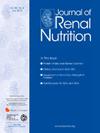Relationship Between Frailty, as Assessed Using the Kihon Checklist, and Falls in Hemodialysis Patients: A Multicenter Prospective Cohort Study
IF 3.2
3区 医学
Q2 NUTRITION & DIETETICS
引用次数: 0
Abstract
Objectives
Hemodialysis (HD) patients are at a high risk of frailty, falls, and fractures. The Kihon checklist (KCL) consists of physical function, cognitive function, oral function, nutritional status, depressed mood, activities of daily living, and social participation. This study aimed to clarify the association between falls in HD patients and frailty as assessed using the KCL, as well as scores and each domain.
Methods
A multicenter prospective cohort study was conducted across 9 facilities. Frailty was assessed using the KCL. Falls were then monitored for 1 year. Participants were classified into 3 groups based on their KCL scores: robust, prefrailty, and frailty. In the logistic regression analysis, the dependent variables were falls, severe falls, or fractures, whereas the independent variables were group classification, KCL score, or each domain.
Results
A total of 403 HD patients (70.0 [60.0-76.0] years, 170 [42.1%] women) were analyzed. During the 1-year follow-up period, 117 (29.0%) patients experienced falls. Prefrailty (odds ratio (OR) 3.00, 95% confidence interval (CI) 1.17-7.71, P < .001) and frailty (OR 6.79, 95% CI 2.69-17.16, P < .001) were independently associated with falls compared with robust patients. Additionally, the KCL score was associated with severe falls (OR 1.15, 95% CI 1.06-1.25, P = .001) and fracture (OR 1.13, 95% CI 1.01-1.28, P = .04). By KCL domain, physical function (OR 3.46, 95% CI 2.06-5.83, P < .001) and cognitive function (OR 1.74, 95% CI 1.09-2.77, P = .02) were independently associated with falls.
Conclusions
The KCL may be a useful screening tool for estimating fall and fracture risk in this population.
使用 Kihon 检查表评估的虚弱程度与血液透析患者跌倒之间的关系:一项多中心前瞻性队列研究。
目的:血液透析(HD)患者易发生虚弱、跌倒和骨折。Kihon检查表(KCL)包括身体功能、认知功能、口腔功能、营养状况、抑郁情绪、日常生活活动和社会参与。本研究旨在通过使用KCL、评分和每个域来评估HD患者跌倒和虚弱之间的关系。方法:在9个机构进行了一项多中心前瞻性队列研究。使用KCL评估虚弱程度。然后对跌倒情况进行了一年的监测。参与者根据他们的KCL得分分为三组:健全性、虚弱前和虚弱。在logistic回归分析中,因变量为跌倒、严重跌倒或骨折,自变量为分组分类、KCL评分或各域。结果:共分析403例HD患者(70.0[60.0-76.0]岁,女性170例[42.1%])。在1年的随访期间,117例(29.0%)患者出现跌倒。与健壮的患者相比,虚弱前(OR 3.00, 95%CI 1.17-7.71, p < 0.001)和虚弱(OR 6.79, 95%CI 2.69-17.16, p < 0.001)与跌倒独立相关。此外,KCL评分与严重跌倒(OR 1.15, 95%CI 1.06 - 1.25, p = 0.001)和骨折(OR 1.13, 95%CI 1.01-1.28, p = 0.04)相关。通过KCL域,身体功能(OR 3.46, 95%CI 2.06-5.83, p < 0.001)和认知功能(OR 1.74, 95%CI 1.09-2.77, p = 0.02)与跌倒独立相关。结论:KCL可能是评估这类人群跌倒和骨折风险的有用筛查工具。
本文章由计算机程序翻译,如有差异,请以英文原文为准。
求助全文
约1分钟内获得全文
求助全文
来源期刊

Journal of Renal Nutrition
医学-泌尿学与肾脏学
CiteScore
5.70
自引率
12.50%
发文量
146
审稿时长
6.7 weeks
期刊介绍:
The Journal of Renal Nutrition is devoted exclusively to renal nutrition science and renal dietetics. Its content is appropriate for nutritionists, physicians and researchers working in nephrology. Each issue contains a state-of-the-art review, original research, articles on the clinical management and education of patients, a current literature review, and nutritional analysis of food products that have clinical relevance.
 求助内容:
求助内容: 应助结果提醒方式:
应助结果提醒方式:


